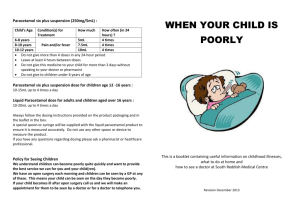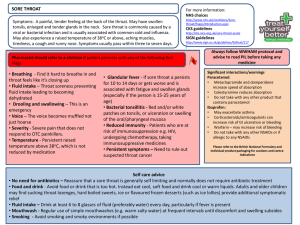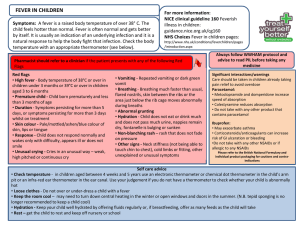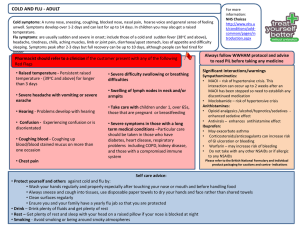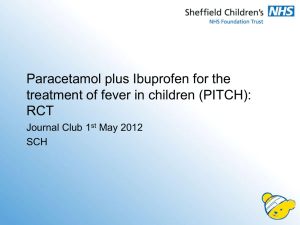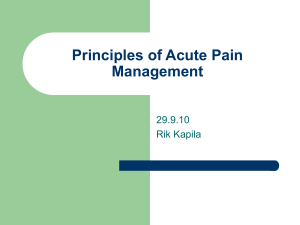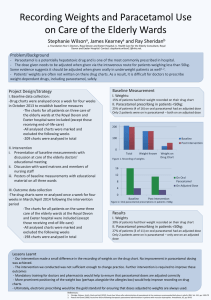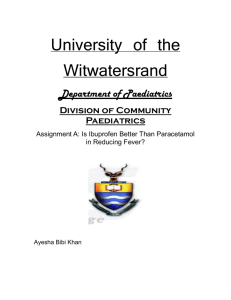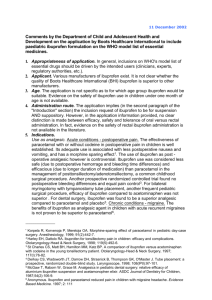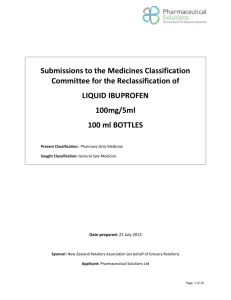Self care pathways earache (Final 2)
advertisement
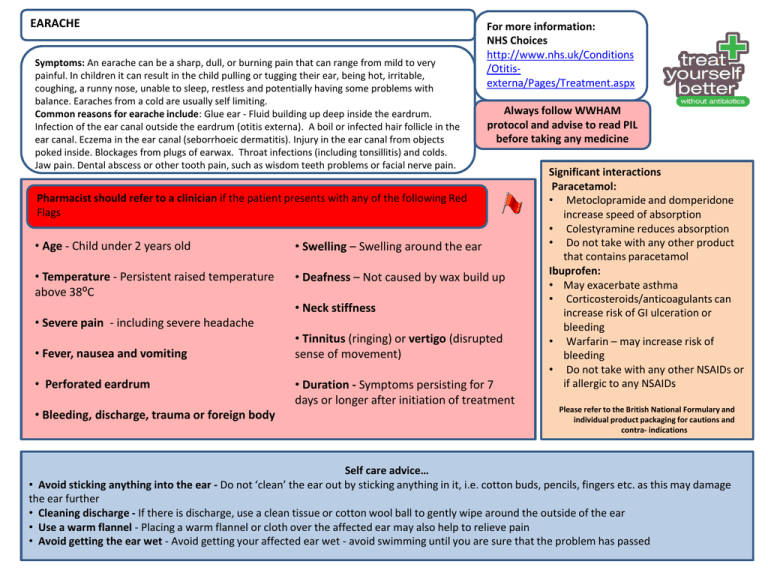
EARACHE Symptoms: An earache can be a sharp, dull, or burning pain that can range from mild to very painful. In children it can result in the child pulling or tugging their ear, being hot, irritable, coughing, a runny nose, unable to sleep, restless and potentially having some problems with balance. Earaches from a cold are usually self limiting. Common reasons for earache include: Glue ear - Fluid building up deep inside the eardrum. Infection of the ear canal outside the eardrum (otitis externa). A boil or infected hair follicle in the ear canal. Eczema in the ear canal (seborrhoeic dermatitis). Injury in the ear canal from objects poked inside. Blockages from plugs of earwax. Throat infections (including tonsillitis) and colds. Jaw pain. Dental abscess or other tooth pain, such as wisdom teeth problems or facial nerve pain. For more information: NHS Choices http://www.nhs.uk/Conditions /Otitisexterna/Pages/Treatment.aspx Always follow WWHAM protocol and advise to read PIL before taking any medicine Pharmacist should refer to a clinician if the patient presents with any of the following Red Flags • Age - Child under 2 years old • Swelling – Swelling around the ear • Temperature - Persistent raised temperature above 38⁰C • Deafness – Not caused by wax build up • Neck stiffness • Severe pain - including severe headache • Fever, nausea and vomiting • Perforated eardrum • Bleeding, discharge, trauma or foreign body • Tinnitus (ringing) or vertigo (disrupted sense of movement) • Duration - Symptoms persisting for 7 days or longer after initiation of treatment Significant interactions Paracetamol: • Metoclopramide and domperidone increase speed of absorption • Colestyramine reduces absorption • Do not take with any other product that contains paracetamol Ibuprofen: • May exacerbate asthma • Corticosteroids/anticoagulants can increase risk of GI ulceration or bleeding • Warfarin – may increase risk of bleeding • Do not take with any other NSAIDs or if allergic to any NSAIDs Please refer to the British National Formulary and individual product packaging for cautions and contra- indications Self care advice… • Avoid sticking anything into the ear - Do not ‘clean’ the ear out by sticking anything in it, i.e. cotton buds, pencils, fingers etc. as this may damage the ear further • Cleaning discharge - If there is discharge, use a clean tissue or cotton wool ball to gently wipe around the outside of the ear • Use a warm flannel - Placing a warm flannel or cloth over the affected ear may also help to relieve pain • Avoid getting the ear wet - Avoid getting your affected ear wet - avoid swimming until you are sure that the problem has passed Treatment option ONE Oral systemic analgesics Adults Ibuprofen 200mg Paracetamol 500mg Always follow WWHAM protocol and advise to read PIL before taking any medicine Adults and children over 12 years: 1 or 2 tablets with water, up to three times daily as required. Leave at least 4 hours between doses. Do not take more than 6 tablets in 24 hours. If symptoms persist for more than 3 days or get worse come back and speak to the pharmacist. Adults and children over 12 years: 1-2 tablets every 4-6 hours, as required. No more than 8 tablets in 24 hours. If symptoms persist for more than 3 days or get worse come back and speak to the pharmacist. Paracetamol will provide pain relief within 30 to 60 minutes. Ibuprofen reduces pain and helps to reduce inflammation. Paracetamol and ibuprofen can be used in conjunction with one another in adults and are safe to be taken at the same time, however there is benefit in taking them 2-3 hours apart. For children 3 to 12 months For children 12 months to 6 years Paracetamol 120mg/5ml suspension (in a dose appropriate for their age) Paracetamol: For both age ranges: No more than 4 doses in 24 hours 3 to 6 months: One 2.5ml dose (60mg) every 4 to 6 hours 6 to 12 months: One 5ml dose (120mg) every 4 to 6 hours Ibuprofen 100mg/5ml suspension (in a dose appropriate for their weight and age) Ibuprofen: 3 to 6 months (if above 5kg): One 2.5ml dose (50mg) 3 times a day (every 6 to 8 hours) 6 to 12 months: One 2.5ml dose (50mg) 3 to 4 times a day (every 6-8 hrs) For both ages: Max 30mg/kg daily in 3-4 divided doses. Not suitable for children under 5kg or under 3 months, or with suspected asthma (unless advised by a doctor) Paracetamol 120mg/5ml suspension (in a dose appropriate for their age) . Paracetamol: For all age ranges: No more than 4 doses in 24 hours 12 months to 2 years: One 5ml dose (120mg) every 4 to 6 hours 2 to 4 years: One 7.5ml dose (180mg) every 4 to 6 hours 4 to 6 years: One 10ml dose (240mg) every 4 to 6 hours Ibuprofen 100mg/5ml suspension (in a dose appropriate for their weight and age) Ibuprofen: 12 months to 4 years: One 5ml dose (100mg) 3 times a day (every 6-8 hrs) 4 to 6 years: One 7.5ml dose (150mg) 3 times a day (every 6-8 hrs) For both ages: Max 30mg/kg daily in 3-4 divided doses. Not suitable for children with asthma (unless advised by a doctor) Treatment option ONE - continued For children 6 to 12 years Always follow WWHAM protocol and advise to read PIL before taking any medicine Paracetamol 250mg/5ml suspension (in a dose appropriate for their age) Paracetamol: For all age ranges: No more than 4 doses in 24 hours 6 to 8 years: One 5ml dose (240-250mg) every 4 to 6 hours 8 to 10 years: One 7.5ml dose (360-375mg) every 4 to 6 hours 10 to 12 years: One 10ml dose (480-500mg) every 4 to 6 hours Ibuprofen 100mg/5ml suspension (in a dose appropriate for their weight and age) Ibuprofen: 6 to 7 years: One 7.5ml dose (150mg) 3 times a day (every 6-8 hrs) 7 to 10 years: One 10ml dose (200mg) 3 times a day (every 6-8 hrs) 10 to 12 years: One 15ml dose (300mg) 3 times a day (every 6-8 hrs) For both ages: Max 30mg/kg (up to 2.4g) daily in 3-4 divided doses. Not suitable for children with asthma (unless advised by a doctor) Paracetamol and ibuprofen should not be given at the same time in children. If the child does not respond to one then the alternative can be considered for the next dose. Note – individual product licenses for age/dose for ibuprofen products may vary. Always check the pack for details. Treatment should only be continued as long as child is responding up to a max 3 days. Choline salicylate (Earex Plus) Adults and children over 1 years: Drops should be instilled into the ear canal and plugged with cotton wool soaked with the ear drops. This should be repeated every 3 – 4 hours. If symptoms persist for more than 7 days or get worse consult your doctor. Additional treatment options Paracetamol +/Ibuprofen Paracetamol or Ibuprofen can be taken in conjunction with Earex Plus – doses as above Most earaches are self-limiting and will clear up on their own within a week. Follow-up Treatment – Pharmacist only Always follow WWHAM protocol and advise to read PIL before taking any medicine Adults and children over 12 years: 1 or 2 tablets with water, up to three times daily as required. Leave at least 4 hours between doses. Do not take more than 6 tablets in 24 hours. Ibuprofen 200mg If symptoms persist for more than 7 days or get worse consult your doctor Children: Follow the dosing guidance outlined in Treatment option ONE Oral systemic analgesics Adults and children over 12 years: 1-2 tablets every 4-6 hours, as required. No more than 8 tablets in 24 hours. Paracetamol 500mg If symptoms persist for more than 7 days or get worse consult your doctor Children: Follow the dosing guidance outline in Treatment option ONE Paracetamol will provide pain relief within 30 to 60 minutes. Ibuprofen reduces pain and helps to reduce inflammation. Paracetamol and ibuprofen can be used in conjunction with one another in adults and are safe to be taken at the same time, however there is benefit in taking them 2-3 hours apart. Additional treatment options Choline salicylate (Earex Plus) Adults and children over 1 years: Drops should be instilled into the ear canal and plugged with cotton wool soaked with the ear drops. This should be repeated every 3 – 4 hours. If symptoms persist for more than 7 days or get worse consult your doctor. Paracetamol +/- Ibuprofen Paracetamol/Ibuprofen can be taken in conjunction with Earex Plus – doses as above Most earaches are self-limiting and will clear up on their own within a week. If pain persists for longer than 7 days after the start of OTC treatment, the patient should be referred to their GP.
